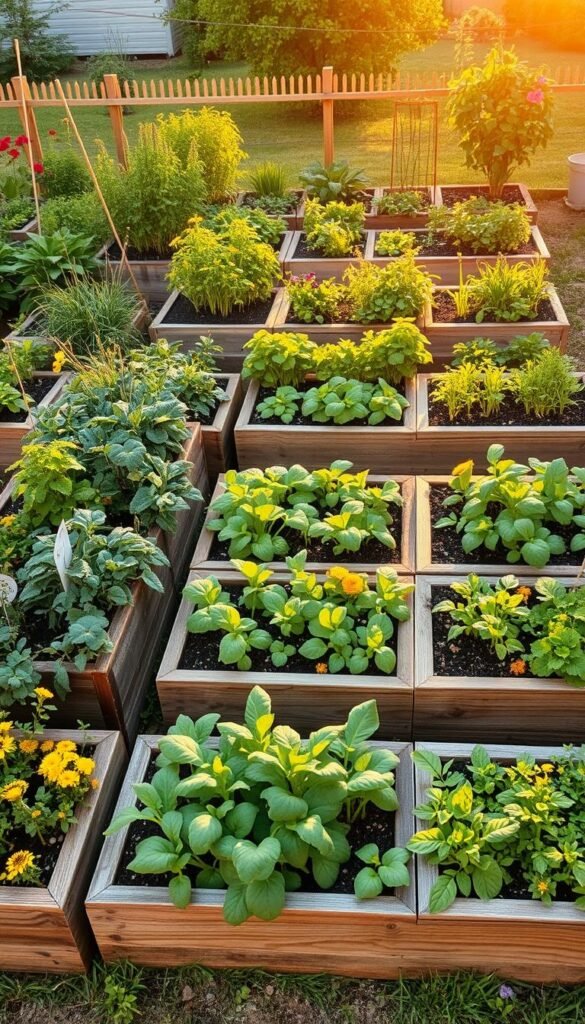Imagine harvesting more vegetables from less space while reducing weeding and watering. The square foot gardening method turns this vision into reality by organizing your growing area into precise 1×1-foot sections. This approach replaces endless rows with compact, manageable squares that boost productivity and simplify maintenance.
Raised beds paired with the Garden Grid™ system create ideal conditions for plant health. By dividing your space into squares, you prevent soil compaction and ensure every seedling gets equal access to nutrients. Studies show this method can produce up to five times more than traditional row planting in the same area.
You’ll love how easy it becomes to calculate spacing needs. No more guessing distances between carrots or tomatoes – each square has predetermined spots for optimal growth. This precision eliminates overcrowding and helps plants thrive through better air circulation and sunlight exposure.
Key Takeaways
- Organize growing areas into 1×1-foot grids for easier management
- Raised beds improve drainage and reduce soil compaction
- Strategic spacing maximizes plant health and yields
- Requires 80% less water than conventional gardening methods
- Perfect for urban spaces and small backyards
- Simplifies crop rotation and pest control
Understanding the Basics of Square Foot Gardening
What if your garden could yield five times more with half the effort? This revolutionary approach organizes your growing space into 12-inch squares, transforming small areas into lush food factories. Let’s break down why this method works so well.
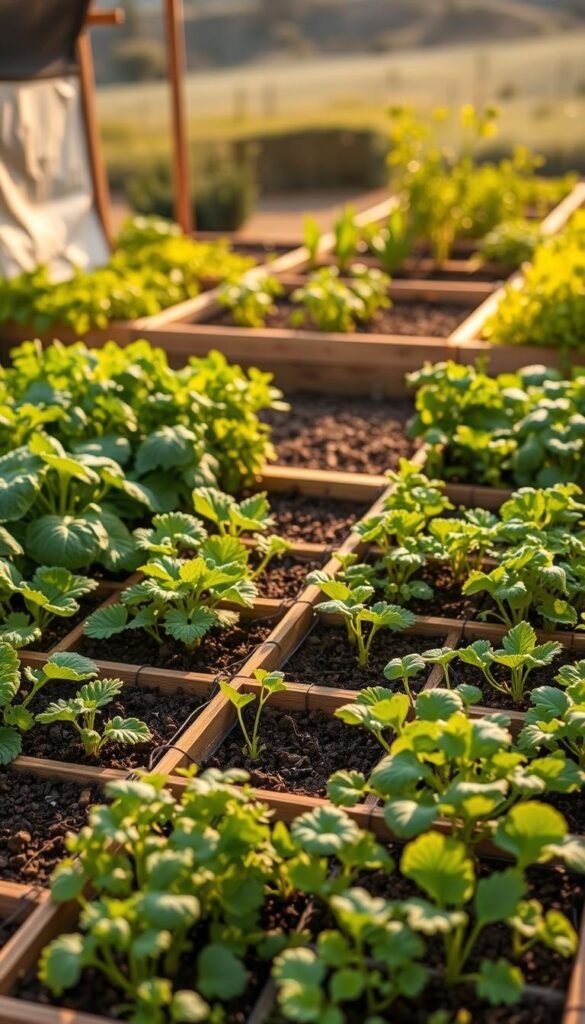
What Is Square Foot Gardening?
Developed by Mel Bartholomew, this method uses raised beds divided into one-foot grids. Instead of long rows, you grow specific numbers of plants per square foot based on their size. Leafy greens like spinach get nine plants per square, while larger veggies like broccoli occupy one whole section.
Key Benefits and Limitations
You’ll spend less time weeding and watering compared to traditional methods. The tight spacing creates natural mulch, and raised beds prevent soil compaction. However, sprawling crops like pumpkins need extra space outside the grid.
| Features | Traditional Gardening | Square Foot Method |
|---|---|---|
| Plant Spacing | Wide rows | Precise grid |
| Water Use | High | 80% less |
| Weeding Time | Weekly | Monthly |
This system shines for urban spaces but requires planning for taller plants. Tomatoes thrive with vertical supports, while root vegetables need deeper soil layers. Mix quick-growing radishes with slower peppers to maximize every square.
Essential Planning Steps for a Productive Garden
Your garden’s success starts with smart spatial decisions. Choosing the perfect spot and designing functional layouts makes maintenance easier while boosting plant health. Let’s explore how to set up your growing area for peak performance.
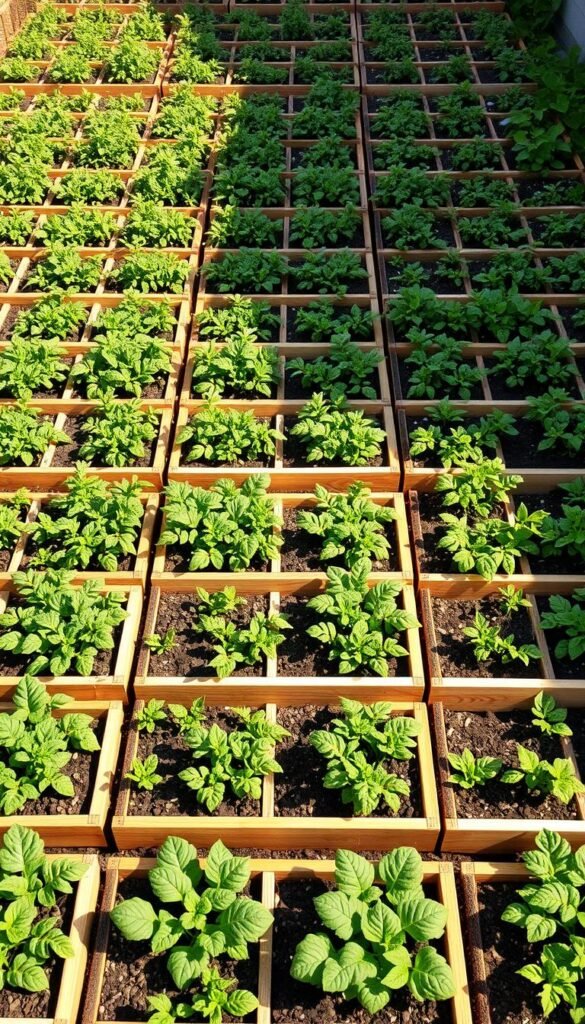
Selecting the Right Raised Beds and Garden Space
Pick locations receiving 6-8 hours of daily sunlight with easy water access. Elevated beds should measure 4 feet wide or less – this keeps every square within arm’s reach. “A 2-foot horizontal reach limit prevents soil compression from leaning,” notes urban farming expert Lisa Johnson.
Opt for cedar or recycled plastic beds 6-12 inches deep. Deeper containers work best for root vegetables, while shallow ones suit leafy greens. Ensure your soil mix contains equal parts compost, vermiculite, and peat moss for drainage and nutrients.
Creating an Effective Grid Layout
Mark your grid using weatherproof materials like cedar strips or nylon twine. Divide beds into clear 1-foot squares – this visual guide eliminates spacing guesswork. Pair plants using vertical space: train cucumbers upward while growing radishes below.
Align rows north-to-south for even sun distribution. Leave 3-foot walkways between beds for comfortable access. Reference spacing charts to determine how many plants fit each square – bush beans allow nine per section, while eggplants need one.
How to Plan a Square Foot Garden for Maximum Yield
Mastering plant placement transforms your growing space into a high-efficiency food producer. Let’s break down the simple math behind perfect spacing using seed packet instructions and grid logic.
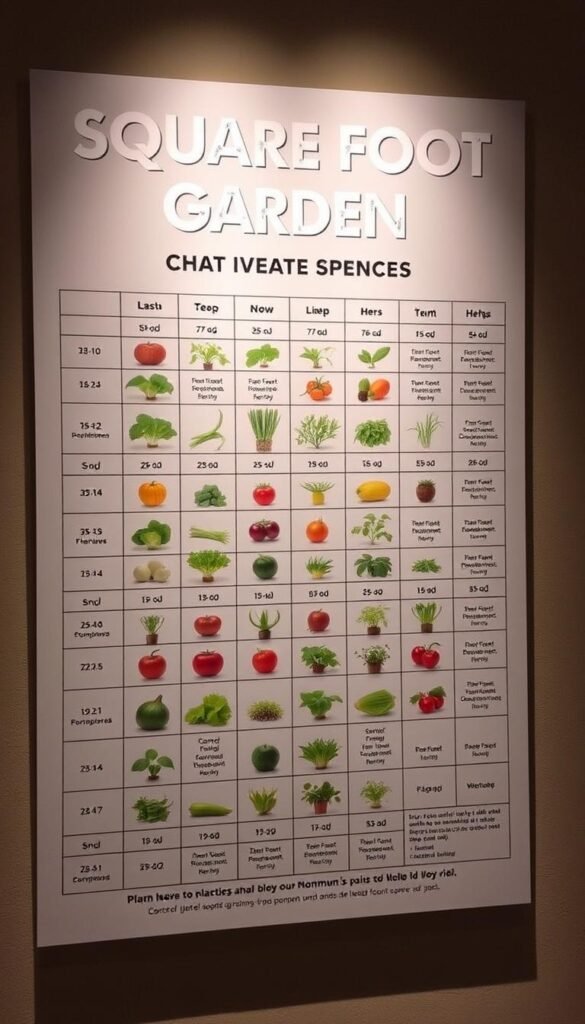
Seed Spacing Made Simple
Forget row measurements – focus on seed-to-seed distances. Here’s the golden formula:
- Divide 12 inches by your seed spacing requirement
- Square the result for total plants per square
Three-inch spacing? (12 ÷ 3 = 4) → 4² = 16 plants. Six-inch gaps? (12 ÷ 6 = 2) → 2² = 4 plants. This method ensures roots never compete for nutrients.
Spacing Chart Success Stories
Reference guides eliminate calculation headaches. Consider these common crops:
| Vegetable | Spacing (inches) | Plants/Square |
|---|---|---|
| Carrots | 3 | 16 |
| Bush Beans | 4 | 9 |
| Peppers | 12 | 1 |
Notice how plant size directly affects numbers. Leafy greens like spinach allow nine per section, while sprawling zucchini needs dedicated squares. Pair quick growers like radishes (16/sq) with slower ones like kale (1/sq) for continuous yields.
Proper spacing prevents disease by improving airflow. Test show correctly spaced tomatoes yield 40% more fruit than crowded plants. Your grid becomes a living blueprint for success!
Optimizing Plant Placement and Crop Rotation
Smart plant organization turns your grid into a powerhouse of productivity. By arranging vegetables based on their needs and relationships, you’ll create a thriving ecosystem that naturally resists pests and preserves soil health.
Group Plants Like a Pro
Cluster crops with similar heights and growth rates to prevent shading. Tall plants like tomatoes work best on the north side of your foot garden, while low-growing herbs thrive in southern squares. Pair quick-harvest radishes (16 per square) with slower cabbage (1 per square) – you’ll reap two crops from one space!
Nature’s Perfect Partners
Companion planting boosts yields through natural synergies. Try these winning combinations:
| Primary Crop | Companion | Benefit |
|---|---|---|
| Tomatoes | Basil | Repels hornworms |
| Cucumbers | Nasturtiums | Deters beetles |
| Carrots | Chives | Confuses root flies |
Rotate plant families annually to keep soil nutrient-rich. Follow heavy feeders like corn with nitrogen-fixing beans, then light-feeding onions. This gardening method prevents disease buildup while maximizing your crop output season after season.
Track your plantings using a simple grid map. Color-code squares by plant family, and note harvest dates. You’ll spot rotation patterns easily while ensuring every inch of your foot garden works efficiently.
Enhancing Soil Nutrition and Efficient Watering Systems
Your garden’s productivity hinges on two key factors: nutrient-rich soil and efficient water use. The right mix beneath your plants’ roots and smart hydration methods work together to create a powerhouse growing environment. Let’s explore how to build both systems for serious results.
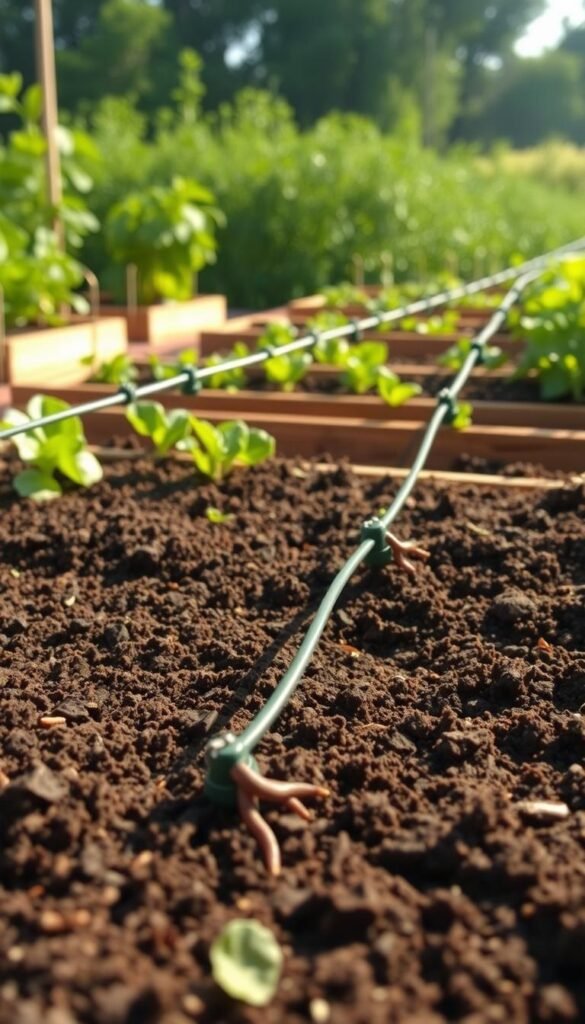
Building a Rich, Nutrient-Dense Soil Mix
Mel Bartholomew’s famous “Mel’s Mix” revolutionized container gardening. This perfect blend combines equal parts compost, vermiculite, and peat moss. The compost delivers nutrients, while vermiculite retains moisture without waterlogging roots.
Refresh your soil each season by adding 1-2 inches of fresh compost. This organic matter feeds plants and improves texture. Test your soil’s pH every spring – most veggies thrive in slightly acidic conditions (6.0-6.8).
For ongoing nutrition, try monthly compost tea applications. One gardener reported 34% larger tomatoes after adopting this routine. Liquid fertilizers work well between plantings, especially in high-density growing areas.
Integrating Modern Irrigation Techniques
The Garden Grid™ system transforms watering from chore to science. This modular setup delivers precise amounts directly to plant roots. You’ll save time while using 60% less water than sprinklers.
Install drip lines or soaker hoses along your grid lines. Water early morning to reduce evaporation. Pair irrigation with 3-inch mulch layers – this dynamic duo keeps soil moist up to 5 days longer.
Monitor plants for hydration clues: wilted morning leaves signal thirst, while yellowing suggests overwatering. Adjust your methods seasonally – leafy greens need more frequent drinks during summer heat.
Experiment with different compost sources and watering schedules. Your unique mix of techniques will evolve into a custom recipe for success. Remember, great gardens grow from the ground up – literally!
Adapting Square Foot Gardening for Intensive Planting
Your thriving garden doesn’t need perfect conditions—just smart adjustments. By tweaking standard techniques, you can grow abundant crops in sweltering deserts or chilly northern climates while keeping plants healthy.
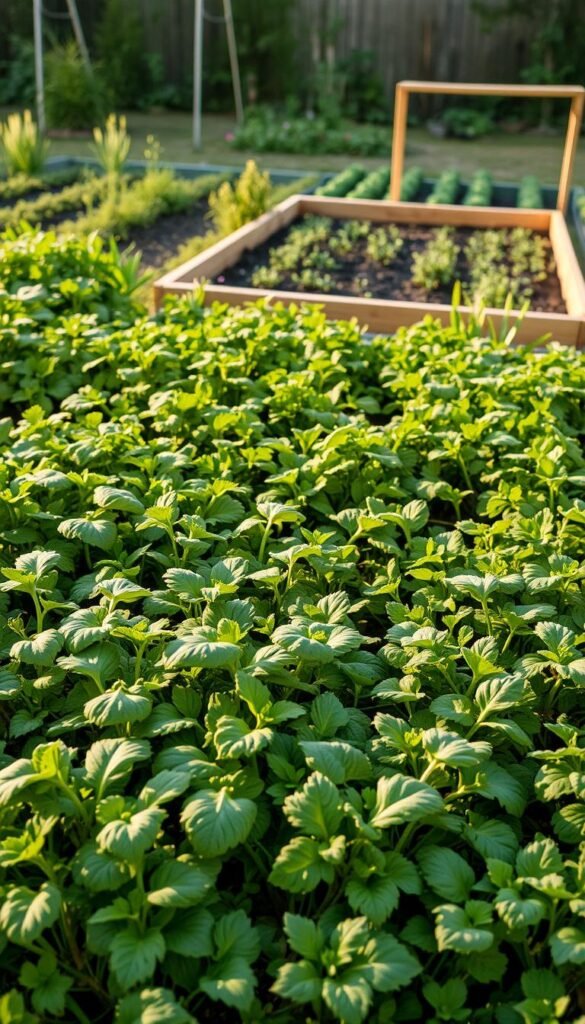
Climate-Smart Modifications
Group plants by size to maximize every square. In cold regions, use deeper squares (18+ inches) for root vegetables and add cloches for frost protection. Southern gardeners might reduce plant counts per square to prevent heat stress. “Grouping small lettuces together creates natural shade for their roots,” shares Colorado grower Mark Tilden.
Density Without Compromise
Delicate herbs like cilantro often need a bit more breathing room—try 4 per square instead of 9. For vining crops, install vertical supports early to save ground space. This table shows adjusted spacing strategies:
| Plant Type | Standard | Intensive |
|---|---|---|
| Basil | 4/sq | 2/sq |
| Kale | 1/sq | 1/sq + radishes |
| Carrots | 16/sq | 12/sq + green onions |
Rotate crops every 6-8 weeks in warm climates to maintain soil health. Leave pathways between beds slightly wider (4 feet) in humid areas for better airflow. Test different layouts each year—you might discover your tomatoes thrive with east-west orientation.
Remember: even crowded gardens need the right amount of resources. Try companion planting in shared squares, like pairing garlic with strawberries for natural pest control. With careful planning, your squares can produce fresh meals year-round!
Conclusion
Transforming small spaces into abundant food sources becomes effortless with grid-based growing. By adopting this method, you’ll harvest fresh produce continuously while using minimal resources. Raised beds paired with the Garden Grid™ system simplify plant care, letting each seedling thrive without competition.
Start by sketching your layout using precise spacing charts. Focus on soil enriched with compost and vermiculite – these elements fuel plant growth naturally. Efficient watering systems like drip lines keep roots hydrated without waste, perfect for urban spaces or compact backyards.
Transitioning from row planting pays dividends quickly. You’ll enjoy five times more food per square foot while reducing maintenance. Even beginners succeed with clear grids and smart crop pairings. Track your progress seasonally, rotating plants to maintain soil vitality.
Ready to taste the difference? Your garden becomes a living grocery store bursting with crisp greens and juicy tomatoes. Explore advanced techniques like vertical growing or succession planting to maximize yields further. Every seed planted brings you closer to sustainable, delicious harvests.
Embrace this innovative approach to homegrown food. With thoughtful planning and the right tools, your compact growing space will outproduce traditional plots. Let fresh flavors and gardening joy redefine what’s possible in your backyard!

